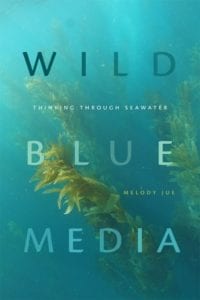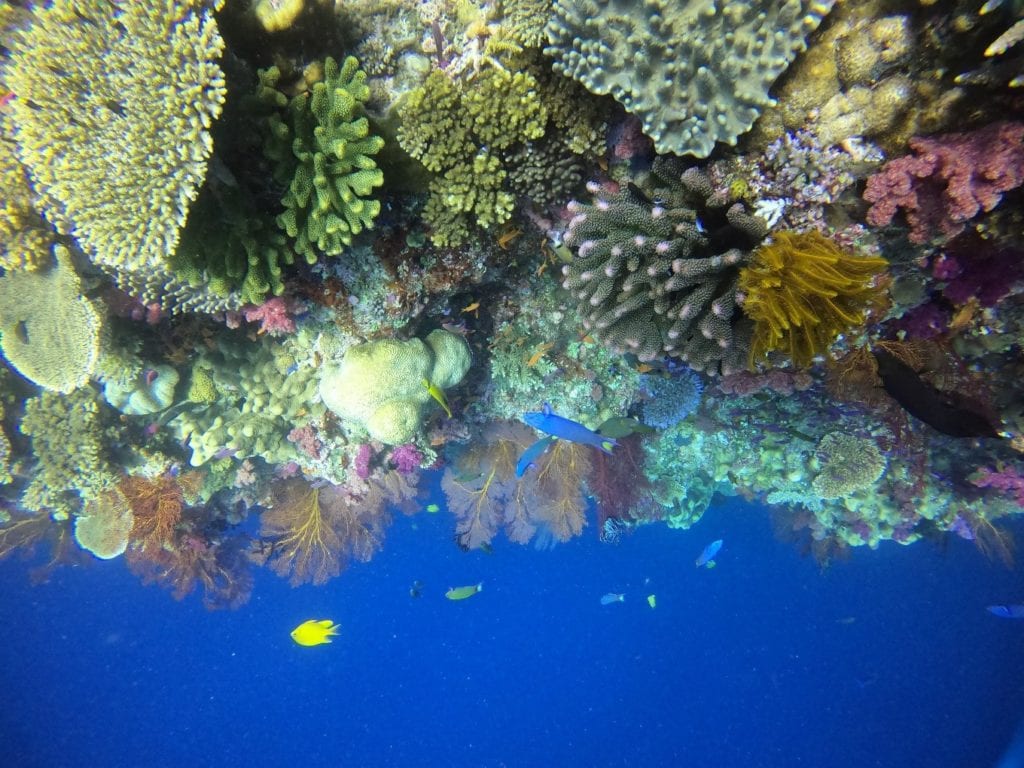By Melody Jue
 The first drips of Wild Blue Media began when I was sitting in a graduate course on theories of “Space and Place.” While I enjoyed many of the readings, it struck me that none of them concerned the ocean, or even water. I had been primed to see this because of watching BBC’s Blue Planet documentary series for relaxation, but of course—as sometimes happens when you’re doing something for fun—I experienced a moment of shock when I realized that David Attenborough’s descriptions of the deep sea tracked very closely to my own interest in science fiction. As Stefan Helmreich would later write, the ocean is often compared to outer space, an extreme environment that requires technical mediation to explore at its greatest depths. However, the ocean is already full of alien creatures whose bodily forms exceed our wildest human imaginations. What perspectives might such creatures have to offer, and how would one even approximate such a narrative position?
The first drips of Wild Blue Media began when I was sitting in a graduate course on theories of “Space and Place.” While I enjoyed many of the readings, it struck me that none of them concerned the ocean, or even water. I had been primed to see this because of watching BBC’s Blue Planet documentary series for relaxation, but of course—as sometimes happens when you’re doing something for fun—I experienced a moment of shock when I realized that David Attenborough’s descriptions of the deep sea tracked very closely to my own interest in science fiction. As Stefan Helmreich would later write, the ocean is often compared to outer space, an extreme environment that requires technical mediation to explore at its greatest depths. However, the ocean is already full of alien creatures whose bodily forms exceed our wildest human imaginations. What perspectives might such creatures have to offer, and how would one even approximate such a narrative position?
As I developed Wild Blue Media, I wanted to think about the relationship between science fiction and the ocean. Rather than reifying the ocean as always already alien or tracking how such narratives circulate, I wanted to think about how the ocean works as a science fictional space for human observers by producing a sense of cognitive estrangement. Cognitive estrangement is a much-discussed concept in science fiction theory coined by Darko Suvin in his classic text Metamorphoses of Science Fiction (1979), reprinted in a wonderful new edition by my friend Gerry Canavan (2016). Suvin drew from Bertolt Brecht’s discussion of Verfremdungseffekt, or “alienation effect,” in theater that shocks audience members out of immersion in watching a play and causes them instead to reflect on their own positionality. Here, it is important that the estrangements of science fiction are a performative effect on the reader (which I outline in a short contribution to SF and the climate crisis). If science fiction is about an incitement to reflexive thinking—of making the familiar or habitual strange—then surely the ocean has a lot to offer in this regard!
It seemed that the best way to think about the ocean as a science fictional medium was to learn how to scuba dive and pay close attention to the phenomenological aspects of this experience. Scuba was something I had wanted to do since I was a small child, so the scholarship really became an alibi for taking the plunge, joyfully, into the ocean. But it was also difficult! There were so many habits to unlearn. In fact, I begin the introduction to Wild Blue Media (available for free here) by talking about the reflex to “stand up” in the water (flipping to the vertical posture) whenever I felt out of control, or like I was falling, rather than maintaining the horizontal fish-like posture encouraged by dive instruction.
 The more time I spent underwater, the greater an appreciation I had for the very particular constraints offered by scuba diving as a form of technical mediation. Yes, you get to spend time underwater looking at fish, but it is always temporary. We all carry hour-glasses on our back (air tanks), like time-traveling sea turtles. In addition, diving safely depends on one’s understanding of tissue saturation. The longer you spend underwater, the more gas becomes absorbed in your blood stream. How much you absorb is related to how deep you have gone and for how long. At a certain point, you need to budget in what’s called a “safety stop” or “decompression stop” at ~15 feet underwater and simply “hang out” for a few minutes, to give your body enough time to exhale the extra absorbed gas. Jacques Cousteau once compared this to slowly opening a bottle of champagne, lest it “explode theatrically.” Americans usually use a soda metaphor to explain the same phenomenon.
The more time I spent underwater, the greater an appreciation I had for the very particular constraints offered by scuba diving as a form of technical mediation. Yes, you get to spend time underwater looking at fish, but it is always temporary. We all carry hour-glasses on our back (air tanks), like time-traveling sea turtles. In addition, diving safely depends on one’s understanding of tissue saturation. The longer you spend underwater, the more gas becomes absorbed in your blood stream. How much you absorb is related to how deep you have gone and for how long. At a certain point, you need to budget in what’s called a “safety stop” or “decompression stop” at ~15 feet underwater and simply “hang out” for a few minutes, to give your body enough time to exhale the extra absorbed gas. Jacques Cousteau once compared this to slowly opening a bottle of champagne, lest it “explode theatrically.” Americans usually use a soda metaphor to explain the same phenomenon.
In the first chapter of my book, I took my newfound literacy of scuba diving and used it to discuss theories of the interface in media and literature. The main conceit is this: what happens if the interface under consideration is not a computer screen but the human lungs during scuba diving? Weaving in discussions of diving memoirs by Jacques Cousteau and Sylvia Earle, as well as a few science fiction stories, I show how the interface isn’t simply something to be “read” or interpreted through visual signs. In an underwater context, the interface has to do with saturation and porosity, in addition to the temporal factor of duration. Much like how Rob Nixon’s concept of “slow violence” allows for different assessments of harm, being able to identify different kinds of environmental interfaces in terms of duration and thickness (rather than pure surface) could contribute to better activist work. I also spend some time talking about debates around surface reading and a hermeneutics of suspicion; yet rather than siding one way or the other, I point out that they both have a shared spatial imaginary: of an observer on the outside, gazing either into the depths or at a surface. The observer is never imagined as within the depths, or in other spatial relationships.
As my science fictional contribution to such theories of interpretation, Wild Blue Media mischievously proposes a method of “conceptual displacement.” What happens when you submerge a familiar concept underwater? Does it hold up under oceanic conditions of immersion, or does the ocean environment require you to reorient your understanding of that very concept? Each chapter of the book submerges a different concept in media theory underwater: interface, inscription, database, and—to gather all three—museums.
The second methodology in Wild Blue Media is called “milieu-specific theory.” Inspired by the way Katherine Hayles talks about “medium-specific theory” in Writing Machines, “milieu-specific theory” is about attending to the conditions of interpretation that are possible within specific milieu, or habitats, or environs. Think about the conditions of scuba diving in the ocean: you have to bring your own air source. Gravity works differently, and often people with mobility issues on land discover a newfound freedom of movement underwater, buoyed by saltwater. You can spin, float, levitate, drift, and enjoy so many postures that can’t be done (slowly) in the air. Light filters through the medium of seawater, such that blues and greens remain but reds are quickly filtered out. If you’ve ever scraped yourself underwater, you know that blood flows green. Sound also travels more quickly than air, and many sea creatures key into vibrations and smells more than visual cues. Captain Nemo’s motto for his ship The Nautilus was famously mobilis in mobili, or “mobile in the mobile element.” And, as Astrida Neimanis writes, the ocean is simultaneously a gestative medium and also a medium of erasure. The fluid of seawater carries so many embryonic forms, ready to grow on many surfaces; and at the same time, the ocean also washes, corrodes, and destroys sunken objects. What kind of theory would be specific to different oceanic environments? What changes if you think about inscription in media theory underwater? Is the ocean a database of genetic material, or, is it an environment that presents an occasion for rethinking what we assume when we imagine conditions of storage? Is there a persistent terrestrial thinking that remains for scholars here?

Although I privilege the ocean here, and contribute to work in the Blue Humanities, I also hope that readers will see how the ocean is a test case for “milieu-specific thinking” that can be taken up in a variety of environmental contexts, in the spirit of recent collections like Prismatic Ecologies. There is a latent milieu-specific thinking in the way anthropologist David Valentine talks about outer space, or the way that Steven Feld talks about the acoustemological space of the rainforest in Papau New Guinea. I was especially encouraged that one of the graduate students here at UCSB, Pujita Guha, found Wild Blue Media useful for her own thinking about phenomenology in mangrove forests.
What Wild Blue Media insists on is the importance of accounting for the relationship between observer and environment and conditions of mediation, all at once. In this way, it adheres closely to the commitments of feminist science studies, especially Donna Haraway’s classic discussion of “situated knowledge” and the value of the partial perspective. Wild Blue Media explores how the ocean might engender a sense of humility among scholars across many humanities fields, if they wish to reflect on the many elements of terrestrial bias that we all bring to our work. The book hopes to estrange scholarly habits of writing in an open-ended way, with the goal of being able to “leave the reader somewhat at sea, but with new tentacles through which to spin yarns” (166).
 Melody Jue is Assistant Professor of English at the University of California, Santa Barbara. She is the author of Wild Blue Media: Thinking Through Seawater (Duke Press 2020) and co-editor, with Rafico Ruiz, of Saturation: An Elemental Politics (Duke Press, forthcoming). Her articles have appeared in Grey Room, Configurations, Women’s Studies Quarterly, Animations, and Humanities Circle, and the collections Scale in Literature & Culture, An Ecotopian Lexicon, and Green Planets: Ecology and Science Fiction.
Melody Jue is Assistant Professor of English at the University of California, Santa Barbara. She is the author of Wild Blue Media: Thinking Through Seawater (Duke Press 2020) and co-editor, with Rafico Ruiz, of Saturation: An Elemental Politics (Duke Press, forthcoming). Her articles have appeared in Grey Room, Configurations, Women’s Studies Quarterly, Animations, and Humanities Circle, and the collections Scale in Literature & Culture, An Ecotopian Lexicon, and Green Planets: Ecology and Science Fiction.
Website: http://www.melodyjue.info/
